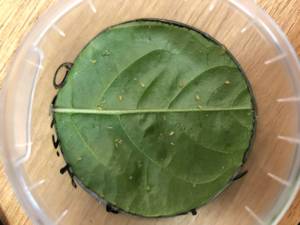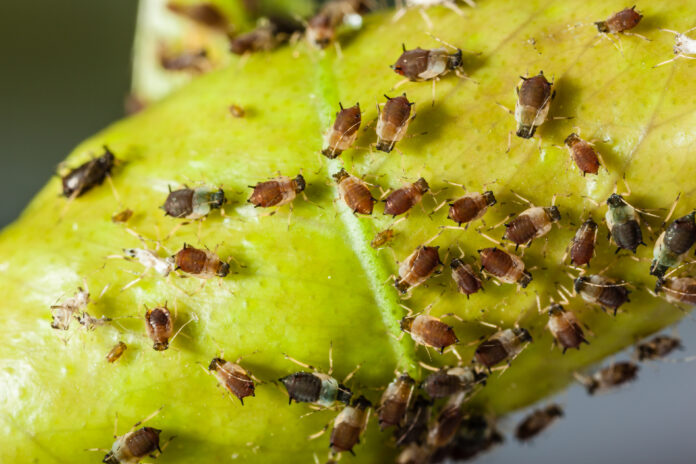Biorationals are registered plant protection products generally derived from the natural environment, offering improved benefits for plants, people and the planet, which are increasingly important factors for Integrated Crop Production to satisfy requirements of the value chain and consumers.

Aulacorthum solani killed by Eradicoat Max (maltodextrine).
Developments in biorational products have been progressing apace in recent years, and indeed, in some crops, such products are now key to modern production methods. However, it is true that the ornamentals sector has always lagged somewhat behind the vegetable sector in terms of the use of biorationals.
Perfect look
One of the main reasons for less easy acceptance and penetration of biorational use in ornamentals is that these crops sell as whole plants or flowers, including leaves, which must look perfect to be acceptable in the market.
If the pest or disease is not controlled quickly and thoroughly enough, then some crop damage will occur from the pest or disease, and then the price of the ornamental plant or flower will fall to close to zero.
Biorational products are mostly not as strong and long-lasting as conventional products, so they do not give 100 per cent control of all insects or fungi. This problem means there is a higher commercial risk in using weaker biorational products in the many varieties grown by an ornamental grower, which has clearly limited the growth of biorational usage in the sector. This limitation does not apply in the same way for food crops.
Last but not least, most Biorationals are contact-based products, so, to be effective, they need to be sprayed to both sides of all leaves. It isn’t easy to achieve this in practice, for example, in pot plants.
Ideal biorationals are crop safe, fast-acting and long-performing
If usage increases, the biorational products need to be crop safe, fast-acting and perform for at least six or seven days. Of course, if this could be guaranteed, levels of uptake would undoubtedly be much higher. Ideally, we would like to have systemic or at least translaminar bio-active ingredients, but they are almost non-existent.
In the current situation, the use of biorationals in ornamentals is highest in the central zone countries, especially in greenhouses, where the climate is controlled, and beneficial insects are also often used successfully.

Leaf disc on agar in a small, vented, plastic box with aphids nymphs.
Biorational products tend to be more compatible with beneficials and thus more used in Integrated Pest Management (IPM) crop programmes. In fruiting vegetables, it is customary to balance the pest and beneficials, and biorationals offers a perfect means to correct that balance if necessary.
It is more challenging to create the balance in ornamentals, and growers have a zero-tolerance of any pest damage by the time they get to harvest – they cannot risk such damage. In principle, every grower is willing to use and/or test biorationals, and the product must be crop safe under all conditions and perform well.
Less availability of chemicals
It has become more challenging to protect crops from aphids in recent years due to the loss of registrations of chemical products. Therefore the demand for more effective biorationals as alternatives is growing.
Certis is a leading player in developing biorationals. Recent findings from some of its work on aphid control illustrate the complexity of the challenge to meet all the necessary criteria for successful solutions that will be acceptable to ornamentals growers..
Trials at the World HortiCenter in the Netherlands
Another way to crack down on New biorational products and some insecticides already registered against whitefly and thrips were tested on aphids. The trials started on a small scale, and the first screening was to check if the products showed efficacy given optimal application and under ideal conditions. Researchers put a leaf disc on agar in a small, vented plastic box with aphid nymphs or adults. The aphids received a treatment of different screening products and different dose rates. After two days and seven days, the aphids were counted (live and dead).
- Some products showed excellent efficacy on aphids, even with low dose rates.
- Others showed an apparent dose-rate effect.
- Some others showed hardly any efficacy at all.
- There were also differences between levels of efficacy on nymphae and on adult aphids.
The results also showed something about the mode of action of the products:
- Physical acting insecticides like fatty acids (Neudosan) or maltodextrin (Eradicoat Max) based products showed quick efficacy: the aphids died within a few hours of spraying. When the spray coverage of the insect was sub-optimal, the aphids did not succumb and were able to walk away.
- Entomopathogenic fungi, like Beauveria bassiana (BotaniGard) and azadirachtin (Azatin), are more slow-acting products that showed poor results after two days but much better efficacy after a week.
Azadirachtin was more effective on nymph stages than on adults with less offspring observed. Azadirachtin is an Insect Growth Regulator (IGR), so these results are not a surprise and can be explained by the mode of action, which prevents the young’s next larvae stage/development stage aphids. Its other mode of action is a repellent effect, and this was more difficult to see in these petri dish trials but was observable in practice after more crop applications.
The screening was on different species of aphids: glasshouse potato aphid (Aulacorthum solani), peach aphid (Myzus persicae) and cotton aphid (Aphis gossypii).
- Eradicoat Max showed better efficacy on cotton aphids than the other species, probably because the cotton aphid is smaller than different types of aphids. It is easier to achieve good coverage with the spray solution.
- Neudosan showed excellent efficacy on all different types of aphids.
Good coverage is essential for both products (Neudosan and Eradicoat Max) and is easy to manage in the petri dish trials but much more difficult in crops. It is not only the product’s efficacy that matters: the application technique and the conditions are also critical. For example, in situations where the product will dry quickly, the effectiveness of Eradicoat Max improves.
After this screening, the products will be tested on plants in a more practical setting.
The search for satisfactory solutions continues, including the biorational products themselves, the techniques used to apply them, and the conditions of ornamental production.
This article was first published in FloraCulture International in October 2021.
Read original article here.








